+ Open data
Open data
- Basic information
Basic information
| Entry | Database: PDB / ID: 7pxg | ||||||
|---|---|---|---|---|---|---|---|
| Title | Verruculogen-bound Drosophila Slo channel | ||||||
 Components Components | Isoform J of Calcium-activated potassium channel slowpoke | ||||||
 Keywords Keywords | TRANSPORT PROTEIN / Potassium transport / BK channel | ||||||
| Function / homology |  Function and homology information Function and homology informationSperm Motility And Taxes / negative regulation of neuromuscular synaptic transmission / male courtship behavior, veined wing generated song production / regulation of synaptic assembly at neuromuscular junction / large conductance calcium-activated potassium channel activity / calcium-activated potassium channel activity / circadian behavior / monoatomic ion channel complex / potassium ion transmembrane transport / circadian rhythm ...Sperm Motility And Taxes / negative regulation of neuromuscular synaptic transmission / male courtship behavior, veined wing generated song production / regulation of synaptic assembly at neuromuscular junction / large conductance calcium-activated potassium channel activity / calcium-activated potassium channel activity / circadian behavior / monoatomic ion channel complex / potassium ion transmembrane transport / circadian rhythm / potassium ion transport / postsynaptic membrane / neuron projection / response to xenobiotic stimulus / neuronal cell body / membrane / plasma membrane Similarity search - Function | ||||||
| Biological species |  | ||||||
| Method | ELECTRON MICROSCOPY / single particle reconstruction / cryo EM / Resolution: 2.73 Å | ||||||
 Authors Authors | Raisch, T. / Brockmann, A. / Ebbinghaus-Kintscher, U. / Freigang, J. / Gutbrod, O. / Kubicek, J. / Maertens, B. / Hofnagel, O. / Raunser, S. | ||||||
| Funding support |  Germany, 1items Germany, 1items
| ||||||
 Citation Citation |  Journal: Nat Commun / Year: 2021 Journal: Nat Commun / Year: 2021Title: Small molecule modulation of the Drosophila Slo channel elucidated by cryo-EM. Authors: Tobias Raisch / Andreas Brockmann / Ulrich Ebbinghaus-Kintscher / Jörg Freigang / Oliver Gutbrod / Jan Kubicek / Barbara Maertens / Oliver Hofnagel / Stefan Raunser /  Abstract: Slowpoke (Slo) potassium channels display extraordinarily high conductance, are synergistically activated by a positive transmembrane potential and high intracellular Ca concentrations and are ...Slowpoke (Slo) potassium channels display extraordinarily high conductance, are synergistically activated by a positive transmembrane potential and high intracellular Ca concentrations and are important targets for insecticides and antiparasitic drugs. However, it is unknown how these compounds modulate ion translocation and whether there are insect-specific binding pockets. Here, we report structures of Drosophila Slo in the Ca-bound and Ca-free form and in complex with the fungal neurotoxin verruculogen and the anthelmintic drug emodepside. Whereas the architecture and gating mechanism of Slo channels are conserved, potential insect-specific binding pockets exist. Verruculogen inhibits K transport by blocking the Ca-induced activation signal and precludes K from entering the selectivity filter. Emodepside decreases the conductance by suboptimal K coordination and uncouples ion gating from Ca and voltage sensing. Our results expand the mechanistic understanding of Slo regulation and lay the foundation for the rational design of regulators of Slo and other voltage-gated ion channels. | ||||||
| History |
|
- Structure visualization
Structure visualization
| Movie |
 Movie viewer Movie viewer |
|---|---|
| Structure viewer | Molecule:  Molmil Molmil Jmol/JSmol Jmol/JSmol |
- Downloads & links
Downloads & links
- Download
Download
| PDBx/mmCIF format |  7pxg.cif.gz 7pxg.cif.gz | 648.6 KB | Display |  PDBx/mmCIF format PDBx/mmCIF format |
|---|---|---|---|---|
| PDB format |  pdb7pxg.ent.gz pdb7pxg.ent.gz | 521.9 KB | Display |  PDB format PDB format |
| PDBx/mmJSON format |  7pxg.json.gz 7pxg.json.gz | Tree view |  PDBx/mmJSON format PDBx/mmJSON format | |
| Others |  Other downloads Other downloads |
-Validation report
| Summary document |  7pxg_validation.pdf.gz 7pxg_validation.pdf.gz | 2.1 MB | Display |  wwPDB validaton report wwPDB validaton report |
|---|---|---|---|---|
| Full document |  7pxg_full_validation.pdf.gz 7pxg_full_validation.pdf.gz | 2.1 MB | Display | |
| Data in XML |  7pxg_validation.xml.gz 7pxg_validation.xml.gz | 110.5 KB | Display | |
| Data in CIF |  7pxg_validation.cif.gz 7pxg_validation.cif.gz | 161.4 KB | Display | |
| Arichive directory |  https://data.pdbj.org/pub/pdb/validation_reports/px/7pxg https://data.pdbj.org/pub/pdb/validation_reports/px/7pxg ftp://data.pdbj.org/pub/pdb/validation_reports/px/7pxg ftp://data.pdbj.org/pub/pdb/validation_reports/px/7pxg | HTTPS FTP |
-Related structure data
| Related structure data |  13702MC  7pxeC  7pxfC  7pxhC M: map data used to model this data C: citing same article ( |
|---|---|
| Similar structure data |
- Links
Links
- Assembly
Assembly
| Deposited unit | 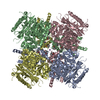
|
|---|---|
| 1 |
|
- Components
Components
-Protein , 1 types, 4 molecules ABCD
| #1: Protein | Mass: 130919.094 Da / Num. of mol.: 4 Source method: isolated from a genetically manipulated source Source: (gene. exp.)   Trichoplusia ni (cabbage looper) / References: UniProt: Q03720 Trichoplusia ni (cabbage looper) / References: UniProt: Q03720 |
|---|
-Non-polymers , 6 types, 32 molecules 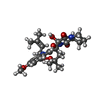










| #2: Chemical | ChemComp-8H5 / #3: Chemical | ChemComp-CA / #4: Chemical | ChemComp-MG / #5: Chemical | ChemComp-6PL / ( #6: Chemical | ChemComp-CLR / #7: Chemical | ChemComp-K / |
|---|
-Details
| Has ligand of interest | Y |
|---|
-Experimental details
-Experiment
| Experiment | Method: ELECTRON MICROSCOPY |
|---|---|
| EM experiment | Aggregation state: PARTICLE / 3D reconstruction method: single particle reconstruction |
- Sample preparation
Sample preparation
| Component | Name: Slo tetramer / Type: COMPLEX / Entity ID: #1 / Source: RECOMBINANT |
|---|---|
| Source (natural) | Organism:  |
| Source (recombinant) | Organism:  Trichoplusia ni (cabbage looper) Trichoplusia ni (cabbage looper) |
| Buffer solution | pH: 7.7 |
| Specimen | Embedding applied: NO / Shadowing applied: NO / Staining applied: NO / Vitrification applied: YES |
| Vitrification | Cryogen name: ETHANE |
- Electron microscopy imaging
Electron microscopy imaging
| Experimental equipment |  Model: Titan Krios / Image courtesy: FEI Company |
|---|---|
| Microscopy | Model: FEI TITAN KRIOS |
| Electron gun | Electron source:  FIELD EMISSION GUN / Accelerating voltage: 300 kV / Illumination mode: OTHER FIELD EMISSION GUN / Accelerating voltage: 300 kV / Illumination mode: OTHER |
| Electron lens | Mode: BRIGHT FIELD |
| Image recording | Electron dose: 80.4 e/Å2 / Film or detector model: GATAN K3 BIOQUANTUM (6k x 4k) |
- Processing
Processing
| Software | Name: PHENIX / Version: 1.19_4085: / Classification: refinement | ||||||||||||||||||||||||||||||||||||
|---|---|---|---|---|---|---|---|---|---|---|---|---|---|---|---|---|---|---|---|---|---|---|---|---|---|---|---|---|---|---|---|---|---|---|---|---|---|
| EM software |
| ||||||||||||||||||||||||||||||||||||
| CTF correction | Type: PHASE FLIPPING AND AMPLITUDE CORRECTION | ||||||||||||||||||||||||||||||||||||
| Particle selection | Num. of particles selected: 1131410 | ||||||||||||||||||||||||||||||||||||
| Symmetry | Point symmetry: C4 (4 fold cyclic) | ||||||||||||||||||||||||||||||||||||
| 3D reconstruction | Resolution: 2.73 Å / Resolution method: FSC 0.143 CUT-OFF / Num. of particles: 66077 / Symmetry type: POINT | ||||||||||||||||||||||||||||||||||||
| Atomic model building | PDB-ID: 5TJ6 Accession code: 5TJ6 / Source name: PDB / Type: experimental model |
 Movie
Movie Controller
Controller






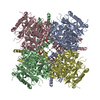
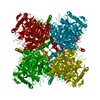
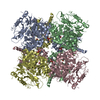
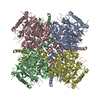

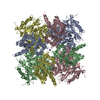

 PDBj
PDBj













